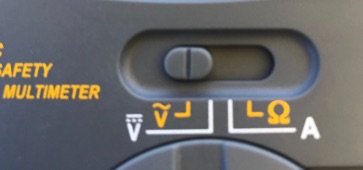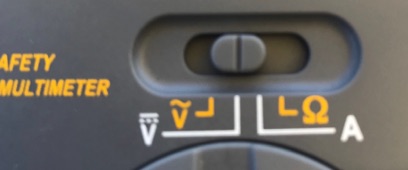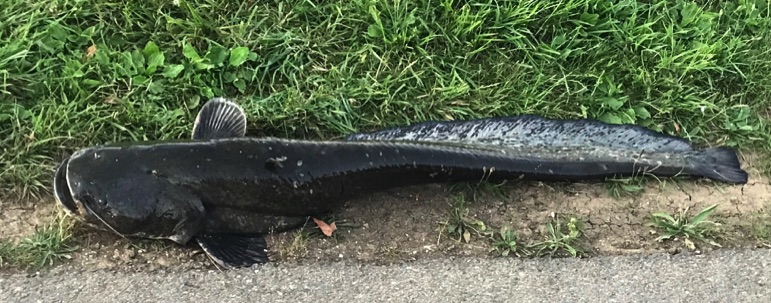
Mon 13 June - awake early, boat check, photos, multimeter, C7, ragodin, silure
I woke early at 0400h, and lay there thinking about MicroGrids for several hours, in anticipation of getting the report finished for Murrindindi Shire by the end of June. After breakfast, I decided to check some boat operations before our intended departure tomorrow. The main engine started immediately and ran smoothly. I left it running for quite a while to see if the coolant was doing its job, unlike 2019 when it overheated within 10 minutes of leaving port. All looked OK this year. But when I tried the bowthrusters - NOTHING! This felt similar to what happened a couple of times in Moissac, when it turned out to be solenoid problems. So I read a few articles on the web, and it seemed like it was either the solenoid or simply flat batteries (after standing dormant for 8 months). So I tried measuring the battery voltage, but found that my multimeter was non-functional. So, since we had to go to the shops this morning, I decided to get a new one while I was there.
So we went up to Intermarche and got a set of passport photos for my Carte de Sejour application, and then sent it off by registered post to the Prefecture in Dijon. And then over to Bricomarche to get a new multimeter, and some battery-powered LED lights as emergency repairs for the bathroom, where the main lights have stopped functioning (probably a switch problem). When I got home I measured the voltage of the bowthruster batteries, which are in the bottom of the bedroom wardrobe, and they registered 14v when connected to the shore power charger, and 12.5v when isolated from the charger. So they appeared to be OK. But Rita had also been talking with Hans, our Swiss neighbour, and he soon arrived with his tools and measured the battery charge to be only 7v on each of the two batteries, and declared them dead. I had also been in touch with Phil Tyson and Paul Hayes, and they also diagnosed dead batteries as the most likely problem, especially since they were the original batteries installed 16 years ago! So while I accepted their verdicts, I couldn't understand why I had measured their voltages as 12-14v on each battery. UNTIL, I had a closer look at the multimeter.
Like most multimeters, it was designed to measure both AC and DC voltages, requiring the user to choose whether they want to measure AC or DC. AC voltage is shown by the V with the "tilde" (the little squiggle) on top, while DC voltage has a V with a full line and a dashed line on top. In the photos below, the DC voltage is shown in white typeface at the far left, followed by the AC voltage in yellow, then Resistance (ohms) in yellow and then Ampage in white at the far right. To select the DC voltage, I therefore moved the switch, above the lettering, to the far left in accordance with the position of the DC voltage symbol. However, if you look closely at the photos, you will see that the switch itself has a vertical groove in the middle of it, and when the switch is moved to the far left (as in the photo at left below), this groove aligns with a yellow line which leads to the AC voltage symbol. When the switch is in the "second from left" position (as in the photo at right below), the groove aligns with a white line which leads to the DC voltage symbol. So, the far left position of the switch does not correspond with the label at the far left (which I had sub-consciously assumed it would). When I put the switch to the far left, I was actually trying to measure AC voltage (which is hard to do on a DC battery), and this is why I was getting crazy results. When I moved the switch to the "second from left" position. I was also measuring voltages of 7V, the same as Hans. All very obvious in hindsight, but not very obvious in foresight. It reminded me of the error in ballot design (survey method design) in the 2000 USA Presidential Elections, where George W. Bush was narrowly elected President over Al Gore because of an amateur mistake in the design of the ballot forms, which were never subjected to Pilot Testing. This survey design error potentially changed the course of world history!


While the battery voltages were very low, and hence probably irreversible, I tried charging them with the Bosch C7 trickle charger that I had successfully been using on the generator battery. But despite leaving it on overnight to charge each battary separately, it eventually couldn't get them to more than about 10v. So I too reluctantly called them dead. Now it was time to find some replacements at a reasonable cost. I originally looked for like-for-like replacements (12V, AGM, 160Ah), but the costs were prohibitive (500euro per battery). So after more discussion with Phil and Paul, I settled on 130Ah, sealed calcium batteries at about 150euro per battery. But I didn't want to have to wait around Auxonne for them to be delivered, so we decided that we would still head off tomorrow and get the batteries delivered to the Capitainerie at Besançon (who we phoned to confirm their agreement to this arrangement). We figured that many other people had cruised from Auxonne to Besançon without bowthrusters, so surely we could do so as well!
After such a hectic day, we decided to go for a walk along the river after dinner. As we went around the port area, we spotted a baby ragodin in the pool on the side of the path. Unlike adult ragodins which can be 60cm in length, plus tail, this one was only about 30cm long. But he/she seemed to be alone with no adult in sight. Very cute!

We continued south along the river until we reached the area where the Night Markets had been held last year. This year, it seems that there is a presence there every night with a little Ginguette selling food, drinks and refreshments. It seems to be gaining popularity as a gathering place for locals and tourists.

As we returned to the boat, we saw an even more surprising sight near where we hade seen the baby ragodin on the way out. This time it was a local fisherman, and his girlfriend, who had just started to fish in the waters of the port, and had landed a sizeable Silure. These catfish-like creatures are in many French rivers, but rarely seen or caught. This one was caught within 5 minutes of starting to fish. After all the obligatory measurement, weighing and photo taking, the fisherman slipped him back into the water to let him live another day. Just for the record, this was a medium-sized Silure, and was about one metre in length.
